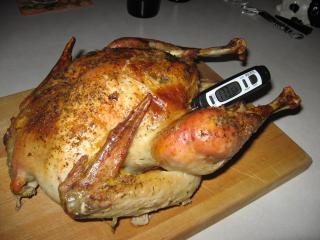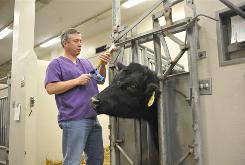
If policy types are going to focus resources, it helps to know where to get the most bang for the regulatory dollar.
Researchers at the University of Florida Emerging Pathogens Institute have attempted to identify the Top 10 riskiest combinations of foods and disease-causing microorganisms.
The report, Ranking the Risks: The 10 Pathogen-Food Combinations with the Greatest Burden on Public Health, lists the number of illnesses, costs, and overall public health burden of specific .jpg) microbes in particular types of food. The list includes:
microbes in particular types of food. The list includes:
Campylobacter in poultry — costs $1.3 billion a year
Toxoplasma in pork — costs $1.2 billion a year
Listeria in deli meats — costs $1.1 billion a year
Salmonella in poultry — costs $700 million a year
Listeria in dairy products — costs $700 million a year
Salmonella in complex foods — costs $600 million a year
Norovirus in complex foods — costs $900 million a year
Salmonella in produce — costs $500 million a year
Toxoplasma in beef — costs $700 million a year
Salmonella in eggs — costs $400 million a year
“The number of hazards and scale of the food system make for a critical challenge for consumers and government alike,” said Michael Batz, lead author of the report and head of Food Safety Programs at the Emerging Pathogens Institute. “Government agencies must work together to effectively target their efforts. If we don’t identify which pairs of foods and microbes present the greatest burden, we’ll waste time and resources and put even more people at risk.”
Of these, the new report concludes that five leading bugs—Campylobacter, Salmonella, Listeria monocytogenes, Toxoplasma gondii, and norovirus – result in $12.7 billion in annual economic loss – with the Top 10 pathogen-food combinations responsible for more than $8 billion. That burden includes the cost of medical care and lost productivity from employee sick days, as well as the expense of serious complications or chronic disabilities that result from the acute illness or sometimes strike after acute illness goes away.
Douglas Archer, associate dean for research at the UF Institute of Food and Agricultural Sciences who reviewed the report, told The Gainesville Sun, "You can’t inspect away foodborne illnesses.”
Of course, a farming rep told the Sun, food producers have to be diligent in ensuring food safety, but the public also has to play a role.
Frankie Hall, director of agricultural policy for the Florida Farm Bureau said, producers can do a good job only to have the person who takes the food home handle it improperly, adding, "There is .jpg) responsibility for food safety when you get it back to the home.”
responsibility for food safety when you get it back to the home.”
J. Glenn Morris, the director of the Emerging Pathogens Institute at the University of Florida and one of the authors of the study told the Washington Post that policymakers at the USDA, which regulates meat, poultry and some egg products, and the FDA, which oversees the rest of the food supply, should consider the economic burden on society when deciding how to direct food safety resources, adding, “You can begin to use these more sophisticated analytic tools, which can serve as the basis of spending public dollars in terms of food safety.”
The report, which was supported by a grant from the Robert Wood Johnson Foundation, includes the following key findings and recommendations for food safety officials:
• Poultry contaminated with Camplylobacter bacteria topped the list, sickening more than 600,000 Americans at a cost of $1.3 billion per year. Salmonella in poultry also ranks in the Top 10, with $700 million due to costs of illness. Infections with these microorganisms can cause acute illness such as vomiting but also can lead to hospitalization or death. Campylobacter infection can also cause paralysis and other neuromuscular problems. The report questions whether new safety standards announced by the USDA for young chickens and turkeys are sufficient, and recommends evaluating and tightening these standards over time.
• Salmonella is the leading disease-causing bug overall, causing more than $3 billion in disease burden annually. In addition to poultry, Salmonella-contaminated produce, eggs and multi-ingredient foods all rank in the Top 10. The report recommends that the FDA and USDA develop a joint Salmonella initiative that coordinates efforts in a number of foods.
• Four combinations in the Top 10 – Listeria in deli meats and soft cheeses, and Toxoplasma in pork and beef – pose serious risks to pregnant women and developing fetuses, causing stillbirth or infants born with irreversible mental and physical disabilities. The report recommends that agencies strengthen prevention programs for these pathogens and improve education efforts aimed at pregnant women.
• Norovirus is the most common foodborne pathogen and is largely associated with multi-ingredient items that can become contaminated, often by service-industry workers who handle .jpg) food. The researchers recommend strengthening state and local food safety programs through increased funding, training and adoption by states of the most recent FDA Food Code.
food. The researchers recommend strengthening state and local food safety programs through increased funding, training and adoption by states of the most recent FDA Food Code.
• The report lists E. coli O157:H7 as the sixth pathogen in overall burden, with the majority due to contaminated beef and produce. The report recommends federal agencies continue to target E. coli O157:H7, due to the particularly devastating injuries it causes in small children, including kidney failure, lifetime health complications, and death.
The report is available at: http://www.epi.ufl.edu/sites/www.epi.ufl.edu/files/RankingTheRisksREPORT.pdf

.jpg) Or under the video section on the front page of
Or under the video section on the front page of .jpg) Most food safety interventions are designed to reduce or eliminate pathogen loads – to lower the number of harmful bugs from farm-to-fork. A piece of highly-contaminated meat can wreck cross-contamination havoc in a food service or home kitchen.
Most food safety interventions are designed to reduce or eliminate pathogen loads – to lower the number of harmful bugs from farm-to-fork. A piece of highly-contaminated meat can wreck cross-contamination havoc in a food service or home kitchen.  Field trials of the Epitopix vaccine showed that 86% of vaccinated cattle stopped shedding O157:H7 bacteria in their feces. Of those that still were shedding bacteria, there was a 98% reduction in the amount, says Daniel Thomson (left, photo from USA Today), a veterinarian and professor of Production Medicine at Kansas State University in Manhattan, Kan., who has studied the effectiveness of vaccine for the company.
Field trials of the Epitopix vaccine showed that 86% of vaccinated cattle stopped shedding O157:H7 bacteria in their feces. Of those that still were shedding bacteria, there was a 98% reduction in the amount, says Daniel Thomson (left, photo from USA Today), a veterinarian and professor of Production Medicine at Kansas State University in Manhattan, Kan., who has studied the effectiveness of vaccine for the company.